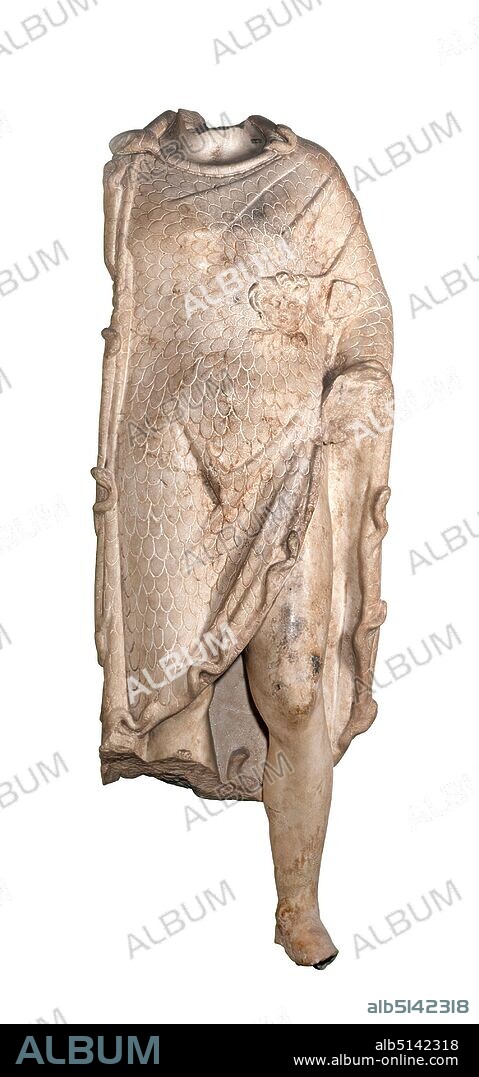alb5142318
Alexander the Great (type Aigiochos), Marble, chiseled, Total: Height: 135.5 cm; Width: 55.5 cm; Depth: 25.5 cm, Three-dimensional sculptures, Portrait of a ruler, State portrait, History of Alexander the Great, Alexander the Great, Middle Imperial Period, Roman copy after a Greek original Under life-size marble statue of a man with a short coat (Greek: Chlamys) in the shape of an Aigis (mythical goatskin). The left arm is bent and stretched out. The right leg was used as a supporting leg, while the left one is slightly bent and set aside to the side. As a robe the figure wears a Macedonian chlamys, a simple garment that is scaled and has a snake edge and a gorgoneion on the chest. Between the gorgoneion and the left elbow is a boss - a reference to a copy of the Roman Imperial period. The back is flat, its elaboration only hinted at. The fact that this statue was placed in a niche testifies to its orientation towards the front. The scale pattern, the snake hem and the gorgoneion may have been colored in the past, as evidenced by small traces of red paint on the edges of the scales. Due to further copies of this type, where the head is preserved, this statue can be safely named as that of the Macedonian king Alexander the Great (r. 336-323 BC). Originally, he still held a scepter and - like the father of the gods Zeus - a bundle of lightning in his hands. Already in Homer's Iliad Zeus is mentioned as the aegis bearer. Alexander was the first mortal to be depicted with Aigis and Gorgoneion. Possibly this type of statue goes back to a cult image of Alexander as founder of the city of Alexandria. This might not have originated before 311 BC.

|
Add to another lightbox |
|
Add to another lightbox |



Caption:
Alexander the Great (type Aigiochos), Marble, chiseled, Total: Height: 135.5 cm; Width: 55.5 cm; Depth: 25.5 cm, Three-dimensional sculptures, Portrait of a ruler, State portrait, History of Alexander the Great, Alexander the Great, Middle Imperial Period, Roman copy after a Greek original Under life-size marble statue of a man with a short coat (Greek: Chlamys) in the shape of an Aigis (mythical goatskin). The left arm is bent and stretched out. The right leg was used as a supporting leg, while the left one is slightly bent and set aside to the side. As a robe the figure wears a Macedonian chlamys, a simple garment that is scaled and has a snake edge and a gorgoneion on the chest. Between the gorgoneion and the left elbow is a boss - a reference to a copy of the Roman Imperial period. The back is flat, its elaboration only hinted at. The fact that this statue was placed in a niche testifies to its orientation towards the front. The scale pattern, the snake hem and the gorgoneion may have been colored in the past, as evidenced by small traces of red paint on the edges of the scales. Due to further copies of this type, where the head is preserved, this statue can be safely named as that of the Macedonian king Alexander the Great (r. 336-323 BC). Originally, he still held a scepter and - like the father of the gods Zeus - a bundle of lightning in his hands. Already in Homer's Iliad Zeus is mentioned as the aegis bearer. Alexander was the first mortal to be depicted with Aigis and Gorgoneion. Possibly this type of statue goes back to a cult image of Alexander as founder of the city of Alexandria. This might not have originated before 311 BC.
Personalities:
Credit:
Album / quintlox
Releases:
Model: No - Property: No
Rights questions?
Rights questions?
Image size:
2020 x 4320 px | 25.0 MB
Print size:
17.1 x 36.6 cm | 6.7 x 14.4 in (300 dpi)
Keywords:
311 BC • AEGIS BEARER • AIGIS • ALEXANDER • ALEXANDRIA • ANATOMY: HEAD • BACK • BENT • BOSOM • BOSS • BREAST • BUNDLE • CHEST • CHIEF • CHISELED • CHLAMYS • CHLAMYS, GREEK MANTLE • CITY • COLORED • COLOURED • COPY • CULT IMAGE • DAD • DEPICTED • DEPTH • DUE • EDGES • ÉLABORATION • EVIDENCED • FACT • FATHER • FIGURE WEARS • FIRST MORTAL • FLAT • FORMS (GEOMETRIC) • FOUNDER • FRONT • FRONTAL • FURTHER COPIES • GODS ZEUS • GORGONEION • GREAT • GRECO • GREEK ORIGINAL UNDER LIFE-SIZE MARBLE STATUE • GREEK • GREEKS • HAND • HEAD (ANATOMY) • HEAD (BODY) • HEAD • HELD • HELENICO • HELENISTICO • HELLENIC • HELLENISTIC • HINTED • HISTORIA UNIVERSAL • HISTORIA • HISTORY • HOMER'S ILIAD ZEUS • LEFT ARM • LEFT ELBOW • LEFT • LIGHTNING BOLT • LIGHTNING • MACEDONIAN CHLAMYS • MACEDONIAN KING ALEXANDER • MAN • MARBLE • MARBRE • MEN • MENTIONED • MIDDLE IMPERIAL PERIOD • MIGHT • MYTHICAL GOATSKIN • NICHE TESTIFIES • ORIENTATION TOWARDS • ORIGINALLY • ORIGINATED • PAST • PLACED • PORTRAIT • POTRAIT • PRESERVED • RAY • RAYS • RED PAINT • RÉFÉRENCE • RIGHT LEG • ROBE • ROMAN COPY • ROMAN IMPERIAL PERIOD • RULER • SAFELY • SCALE PATTERN • SCALED • SCALES • SCEPTER AND • SET ASIDE • SHAPE • SHORT COAT • SIDE • SIMPLE GARMENT • SLIGHTLY BENT • SMALL TRACES • SNAKE EDGE • SNAKE HEM • STANDING LEG = SUPPORTING LEG • STANDING LEG • STATE PORTRAIT • STATUE GOES BACK • STATUE • STATUES • STORM • STRETCHED OUT • SUPPORTING LEG • THREE-DIMENSIONAL SCULPTURES • THUNDER • THUNDERSTORM • TOWN • TOWNS • TYPE AIGIOCHOS • TYPE • WEATHER: LIGHTNING
 Pinterest
Pinterest Twitter
Twitter Facebook
Facebook Copy link
Copy link Email
Email

